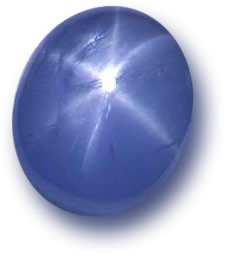 |
| An uncut ruby crystal on a limestone matrix Photo by Rob Lavinsky |
Why rubies
are red is a question that many people ask themselves when they see this
beautiful gemstone that is a member of the larger family of gemstones that are
termed corundum that are
naturally occurring crystals of aluminum oxide. Pure corundum itself is
colorless, but the interjection of those specific metallic
ions as an impurity is what gives all these gems their color. It is a
specific type of impurity chromium
ions that are found replacing some of the aluminum ions in the ruby crystal
creating the red color. Other members of the corundum family are also colored
by the same mechanism only with different ions, or combinations of ions
replacing the aluminum.
In the case of rubies the color you see, red, is because all
the rest of the colors of the rainbow are absorbed within the crystal structure
allowing you to see only red. The entire range of colors that is seen in the
family of corundum gemstones is also based on the same mechanism of absorbation
caused by different metallic ions that have different levels of energy. The
ruby actually has two large absorption bands one of which transmits blue, and
the other transmits red. These bands are
480 nm in blue and 610 nm in red because the 610 nm is more highly energetic
and the light coming from the 480 nm scale. In effect the red light coming from
the gem blanks out the blue light.
| A cut ruby with inclusions Photo by Humanfeather |
The amount of chrome that replaces the
aluminum ions in the crystal lattice determines the density of the red that is
going to appear; the more chromium there is the deeper the red color will be.
Geologically it takes a special set of circumstances to
produce corundum, and especially the variety that we call Ruby. The best rubies
in the world are produced in the Mogok
Valley of Myanmar .
Other rubies are also found in Sri Lanka ,
Madagascar , Africa
and in the Cowee River
Valley Franklin ,
North Carolina
The finest color for Ruby is what they call pigeon blood red that is a deep
red with almost bluish flashes when moved around in the daylight. Rubies also
fluoresce under ultraviolet light source, and in some specimens it is even
possible to see they also fluoresce under the influence of sunlight.
 |
| A red version of this star sapphire would be a star ruby Photo by Ligar |
A large ruby gem weighing more than 10 carats is the most
expensive gemstone on earth being higher-priced than the finest diamonds. Large
masses of imperfect ruby crystals are used extensively for carving. Many of the
rubies that are on the market have been heat-treated to remove the needles of titanium dioxide that
causes them to become cloudy; insert cases however the same needles of rutile produce a star effect
called asterism that causes a star to appear on the face of a cabochon cut stone. Some of
the stones can be almost as valuable as a regular faceted gem.

No comments:
Post a Comment